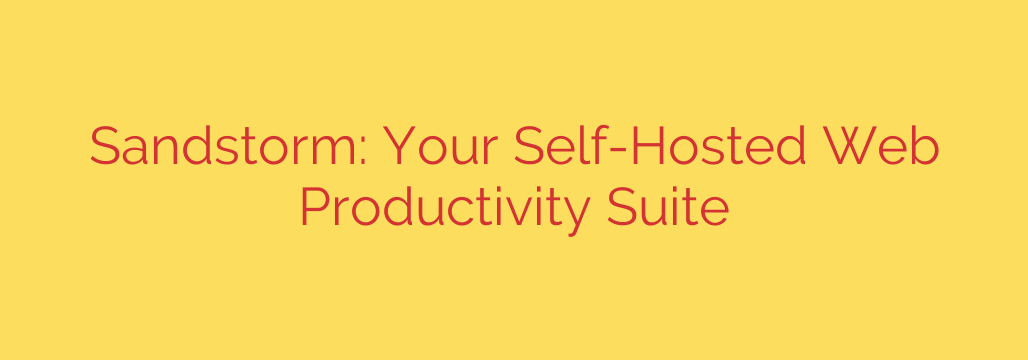
Regain Control of Your Digital Life: A Guide to the Sandstorm Self-Hosted Platform
In an era dominated by cloud services, we’ve traded control for convenience. Our documents, project plans, and private conversations are stored on servers owned by massive corporations, subject to their terms of service and security practices. But what if there was a way to reclaim your data without sacrificing the modern, collaborative tools you rely on?
Enter Sandstorm, a powerful open-source platform that allows you to run your own private cloud server with an entire suite of web applications. It’s a solution designed for individuals, teams, and businesses who value digital sovereignty and want to own their digital workspace. Instead of renting software, you run it yourself, on your own terms.
What Exactly Is Sandstorm?
Think of Sandstorm as a secure operating system for your server, complete with its own app store. Once installed on a machine you control—whether it’s a home server or a virtual private server (VPS)—you can install dozens of productivity and collaboration apps with a single click.
This isn’t just about hosting one or two services. It’s about creating a unified, secure ecosystem where all your tools live together under one roof, accessible through a single login. From document editors and spreadsheets to project management boards and chat clients, Sandstorm provides the foundation for a complete, self-hosted office suite.
A New Paradigm for Security: The Power of “Grains”
Sandstorm’s most significant innovation is its unique security model, which is built around the concept of “grains.”
Each document, chat room, or project board is a separate, isolated container called a grain. This fine-grained containerization means an application doesn’t just get access to your “account”—it only gets access to the specific document you are working on.
This “security-by-default” approach has profound implications:
- Containment of Threats: If a vulnerability is found in one application (like a photo editor), it cannot be used to access your data in another application (like your password manager). The breach is completely contained within that single grain.
- Granular Sharing: When you share a document, you aren’t giving someone access to your account. You are simply sharing a secure link to that specific grain. This power-box model provides permission control at the document level, not the account level, which is a massive leap forward for security and privacy.
- No Central Point of Failure: Unlike traditional monolithic applications, the entire system is decentralized. There is no single user database for all apps to tap into, drastically reducing the attack surface.
Key Features of the Sandstorm Platform
Beyond its robust security, Sandstorm offers a user-friendly experience designed for simplicity and efficiency.
- One-Click App Installation: The Sandstorm App Market features a wide array of open-source applications that can be installed instantly, with no complex configuration required.
- Unified Login: Sign in to your Sandstorm instance once and gain immediate access to all your installed applications without needing to manage separate usernames and passwords.
- Effortless Collaboration: Sharing a document or project is as simple as sending a link. You can grant view-only or full edit access with ease, and revoke it just as quickly.
- Open-Source and Transparent: The entire platform is open-source, meaning its code is available for anyone to inspect. This ensures transparency and allows a global community to contribute to its security and development.
Build Your Own Productivity Suite with Popular Apps
The real power of Sandstorm is realized through the apps you can host. You can easily create a robust alternative to mainstream cloud suites by combining powerful open-source tools. Popular apps available on the market include:
- Wekan: A powerful Kanban board application similar to Trello for managing projects and workflows.
- Etherpad: A real-time collaborative document editor, perfect for meeting notes, brainstorming, and drafting articles.
- Rocket.Chat: A full-featured team communication platform that serves as an excellent alternative to Slack.
- DaviCal: A shared calendar server for scheduling and organizing team events.
- Nextcloud: A file-syncing and sharing platform that gives you your own private Dropbox-style service.
Essential Security Tips for Self-Hosting
Running your own server puts you in control, but it also means you are responsible for its security. If you decide to set up a Sandstorm instance, follow these essential best practices:
- Keep Your System Updated: Regularly apply security patches to the underlying operating system of your server to protect against known vulnerabilities.
- Use Strong Authentication: Protect your Sandstorm account with a strong, unique password and enable two-factor authentication (2FA) if available.
- Implement Regular Backups: Your data is your responsibility. Set up an automated backup system for your Sandstorm server to protect against hardware failure or data corruption.
- Secure Your Network: Use a firewall to restrict access to your server, only allowing connections from trusted networks or through necessary ports.
In conclusion, Sandstorm offers a compelling path for anyone looking to break free from big tech ecosystems and build a more private, secure, and customizable digital workspace. It empowers users with robust security and a vast library of tools, proving that you don’t have to sacrifice modern functionality to achieve true data ownership.
Source: https://www.linuxlinks.com/sandstorm-self-hostable-web-productivity-suite/








